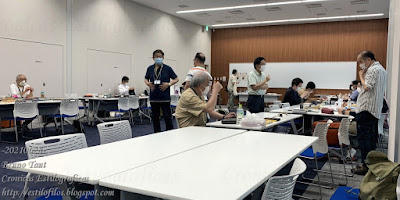Dating Sailor pens in often tricky.
As I have shown previously,
the date stamped on their nibs between the late 1960s and
2017 was a three-digit number, on which the first of them was the last digit of the manufacturing year. And the other two were the month. This system creates a basic uncertainty—to which decade does the first digit belong?
That question is not always easy to answer as some models span their lives over several decades.
Such is the case of the following pen—a “precious wood” made of
tagayasan wood.
Tagayasan (鉄刀木, literally iron sword wood) is the Japanese word for
Senna siamea, one of the multiple variations of ironwood.
 When was this pen made?
When was this pen made?
According to Masa Sunami [Lambrou and Sunami.
Fountain Pens of Japan. 2012], the first wooden pen by Sailor was marketed in 1968 to commemorate the 100th anniversary of the begining of the
Meiji period. That first wooden pen implemented a number of parts from previous models, and by 1972 the idea had adopted a new style and became as well a canvas
for maki-e decorations. These pens, following
the trend of the moment, had 23 K gold nibs.
 This pen, from 1966, served as model for the 1968 wooden pen to commemorate the 100th anniversary of the Meiji Period. The pen in the picture is made of plastic.
This pen, from 1966, served as model for the 1968 wooden pen to commemorate the 100th anniversary of the Meiji Period. The pen in the picture is made of plastic.
 Sailor pen from 1972. The decoration is
Sailor pen from 1972. The decoration is maki-e
over ebony. The nib is made of 23 K Au.
Since then, this model has seen several variations in different materials and finishes—-mammoth ivory, wood,
maki-e decorations--, and with different gold grades for the nib.
 The same pen, this time made of mammoth ivory, a material not subject to restrictions. 1988.
The same pen, this time made of mammoth ivory, a material not subject to restrictions. 1988.
In fact, these pens were included in the Sailor catalog up to 2009 as canvas for the most elaborated
maki-e decorated pens made by Sailor at the time.
 Page 2 of the Sailor catalog of
Page 2 of the Sailor catalog of maki-e
decorated pens of 2008.
So, when was this “tagayasan” pen made?
This pen is a cartridge-converter, as was the case of all Sailor pens made between 1960 and 2006. The nib is made of 18 K gold. Its dating code is 003, meaning March of a year ending in 0.
 Ebony (top) and ironwood (bottom).
Ebony (top) and ironwood (bottom).
 The
The tagayasan
pen, disassembled.
 The nib and the feed. The engravings on the nib read "18 K / SAILOR", "4 003", and the JIS mark. 4 means this is a medium nib.
The nib and the feed. The engravings on the nib read "18 K / SAILOR", "4 003", and the JIS mark. 4 means this is a medium nib.
But, is it 1980, 1990 o 2000? Hard to say.
The closest relative to this
tagayasan pen is a series of precious wood pens prepared by Sailor in 2003 thinking of the US market. However, those pens never entered production [Lambrou and Sunami.
Fountain Pens of Japan. 2012]. But this pen is remarkably similar, including the grade of the gold nibs: 18 K.
This detail makes me think of 2000 as the year of production of this
tagayasan pen. But this is just a speculation. More research is needed.
What we do know, though, is that this is a well-made pen, very reliable, and attractive. And collectable in its relative rarity.
My thanks to Mr. Kanesaki and Mr. Shimizu.
Ohashido - Lamy Petrol
Bruno Taut
Nakano, March 30th, 2021
etiquetas: Sailor

























































